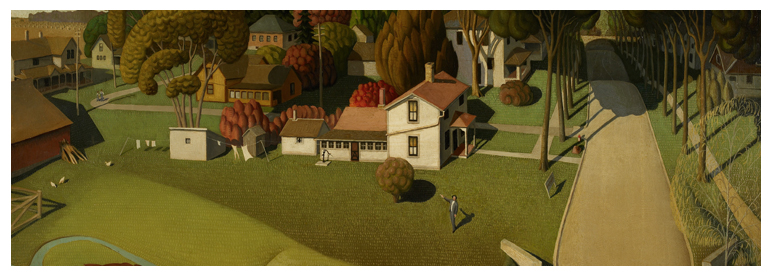
Wood was an active painter from an extremely young age until his death, and although he is best known for his paintings, he worked in a large number of media, including lithography, ink, charcoal, ceramics, metal, wood and found objects.
Throughout his life, he hired out his talents to many Iowa-based businesses as a steady source of income. This included painting advertisements, sketching rooms of a mortuary house for promotional flyers and, in one case, designing the corn-themed decor (including chandelier) for the dining room of a hotel. In addition, his 1928 trip to Munich was to oversee the making of the stained glass windows he had designed for a Veterans Memorial Building in Cedar Rapids. The window was damaged during the 2008 flood and it is currently in the process of restoration.He again returned to Cedar Rapids to teach Junior High students after serving in the army as a camouflage painter.
Wood is associated with the American movement of Regionalism that was primarily situated in the Midwest, and advanced figurative painting of rural American themes in an aggressive rejection of European abstraction.
Wood was one of three artists most associated with the movement. The others, John Steuart Curry and Thomas Hart Benton, returned to the Midwest in the 1930s due to Wood’s encouragement and assistance with locating teaching positions for them at colleges in the states of Wisconsin and Missouri, respectively. Along with Benton, Curry, and other Regionalist artists, Wood’s work was marketed through Associated American Artists in New York for many years. Wood is considered the patron artist of Cedar Rapids, and his childhood country school is depicted on the 2004 Iowa State Quarter.
Wood’s best known work is his 1930 painting American Gothic, which is also one of the most famous paintings in American art, and one of the few images to reach the status of universally recognised cultural icon, comparable to Leonardo da Vinci’s Mona Lisa and Edvard Munch’s The Scream.
It was first exhibited in 1930 at the Art Institute of Chicago, where it is still located. It was given a $300 prize and made news stories country-wide, bringing Wood immediate recognition. Since then, it has been borrowed and satirised endlessly for advertisements and cartoons.
Art critics who had favorable opinions about the painting, such as Gertrude Stein and Christopher Morley, assumed the painting was meant to be a satire of repression and narrow-mindedness of rural small-town life. It was seen as part of the trend toward increasingly critical depictions of rural America, along the lines of Sherwood Anderson’s 1919 Winesburg, Ohio, Sinclair Lewis’ 1920 Main Street, and Carl Van Vechten’s The Tattooed Countess in literature. Wood rejected this reading of it. With the onset of the Great Depression, it came to be seen as a depiction of steadfast American pioneer spirit. Another reading is that it is an ambiguous fusion of reverence and parody.
Wood’s inspiration came from Eldon, southern Iowa, where a cottage designed in the Gothic Revival style with an upper window in the shape of a medieval pointed arch, provided the background and also the painting’s title. Wood decided to paint the house along with “the kind of people I fancied should live in that house.” The painting shows a farmer standing beside his spinster daughter, figures modeled by the artist’s dentist and sister, Nan (1900–1990). Wood’s sister insisted that the painting depicts the farmer’s daughter and not wife, disliking suggestions it was the farmer’s wife, since that would mean that she looks older than Wood’s sister preferred to think of herself. The dentist, Dr. Byron McKeeby (1867–1950) was from Cedar Rapids, Iowa. The woman is dressed in a dark print apron mimicking 19th century Americana with a cameo brooch and a tightly-knotted tie, and the couple are in the traditional roles of men and women, the man’s pitchfork symbolizing hard labor.
The compositional severity and detailed technique derive from Northern Renaissance paintings, which Grant had looked at during three visits to Europe; after this he became increasingly aware of the Midwest’s own legacy, which also informs the work. It is a key image of Regionalism.
Wood was hired in 1940, along with eight other prominent American artists, to document and interpret dramatic scenes and characters during the production of the film The Long Voyage Home, a cinematic adaptation of Eugene O’Neill’s plays.
